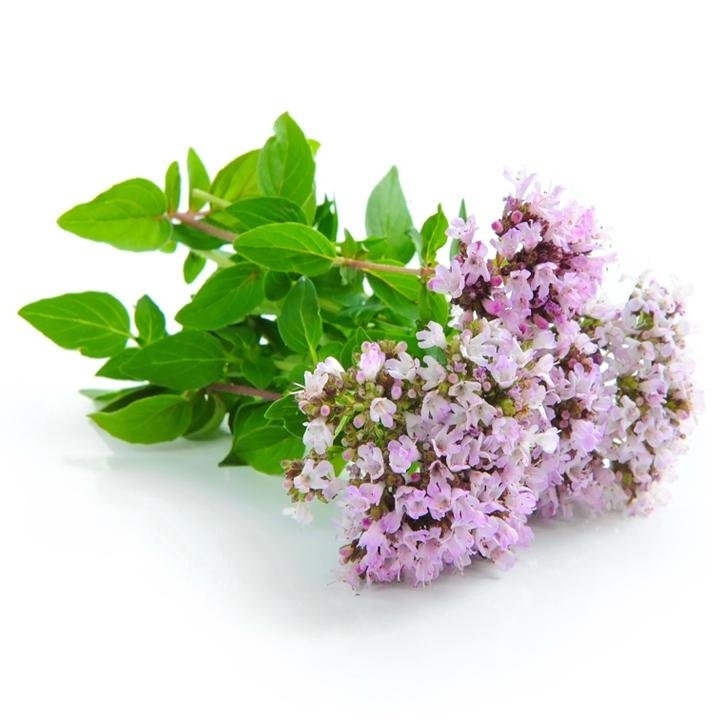Description
It is a herbaceous, vivacious (lives more than two years), perennial and very resistant plant. Stems are erect, branched at the top, prism-shaped, villose, that grows between 30 to 90 cm. It has a creeping rhizome. Leaves are green, entire, oval-shaped, opposite, pointy, hairy beneath, smooth above, 4 cm long, glabrous or pubescent, entire margin or slightly crenate. Leaves have a petiole and are covered by transparent dots holding essential oil within. Flowers are small (petals are not longer than 2-3 mm), purple or pinkish-violet, displaced in terminal inflorescences. Calyx has five equal or almost equal teeth are yellowish and a white, reddish or purple, two-lipped corolla. Bracts are lanceolate or ovoid of up to 5 mm, greenish or purple. Fruit is an oval-shaped and smooth achene. It is small, brown, dry, globose, monosperm and indehiscent. It belongs to the Labiatae family. It’s a very aromatic plant of bitter taste.
It is native of Turkey and was introduce in Europe by mid XVI century and distributed throughout Europe and central Asia. It grows in warm, well-drained soil in full sun. It prefers rocky soils and hillside terrains of up to 2,000 m above sea level. It blooms in summer, beginning in July to August and flower apex are harvested when it is blooming. It is even recommended to wait until some flowers shrivel, as the production of the essence by flowers increases when they are totally developed. Harvesting leaves should be made when plants begin to bloom. They have to be cut several centimeters above the ground. Two harvesting periods take place during the year, one in spring and the other one in summer. For the essence it has to be made when the plant is in full blooming, it is: when 50% of the flowers are open.
Part used
Mainly the flower apex and sometimes the leaves.
Indications
Internal use
- Digestive disorders: nervous origin dyspepsia (indigestion), hyposecretive dyspepsia, flatulence and meteorism, spasms or gastrointestinal colics, lack of appetite, diarrhea.
- Respiratory disorders: dry or irritating cough, laryngitis, pharyngitis, whooping cough, common cold, bronchitis, emphysema, asthma.
- Kidney disorders: nephritis, urethritis, urine retention, edema.
- Hepatobiliary dyskinesia, cholecystitis
- Dysmenorrhea (painful menstrual periods), amenorrhea, pre-menstrual syndrome.
External use
- Muscle pain, rheumatism, arthralgia, stiff neck, lumbago, sciatic nerve pain; it is topically applied in poultices and frictions on the skin.
- Wounds, ulcers, dermatomycosis, dermatitis, itching, insect bites, etc.
- Otitis, rhinitis, sinusitis, odontalgias.
Bibliography
- Plantas Medicinales y Drogas Vegetales para infusión y tisana. S. Cañigueral, R. Vila y M. Wichtl.
- Fitoterapia aplicada. J.B. Peris, G. Stübing y B.Vanaclocha.
- PDR for Herbal Medicines. Medical Economics Company, Montvale. Second Edition. 2000; pp 833-5.
- Blumenthal M, Goldberg A, Brinckmann J. Herbal Medicine, Expanded Commission E Monographs. Integrative Medicine Communications, Newton. First Edition, 2000; pp201-4.
- Fitoterapia. Vademecum de prescripción. B. Vanaclocha y S. Cañigueral. Editorial Masson. 4ª edición.
- J. Bruneton. Farmacognosia.Editorial Acribia, S.A. 2ª edición.
- Max Rombi. 100 Plantes Medicinales. Editions Romart. Deuxieme Edition.
- Catálogo de plantas medicinales. Consejo General de Colegios Oficiales de Farmacéuticos. 2003.
- Bézanger-Beauquesne, Pinkas, Toeck, Trotin.Maloine S.A. 1980. Plantes médicinales des régions tempérées. Paris: Maloine, 1980, p.336.
- Bézanger-Beauquesne, L; Pinkas, M; Torck, M. Les Plantes dans la Therapeutique Moderne. 2ª. Paris: Maloine, 1986, p.304.
- Blumenthal, Busse, Goldberg et al. The Complete German Commission E Monographs. Therapeutic Guide to Herbal Medicines. American Botanical Council. 1998.
- Blumenthal M, Goldberg A, Brinckmann J. Herbal Medicine, Expanded Commission E Monographs. Integrative Medicine Communications, Newton. First Edition, 2000; pp 201-4.
